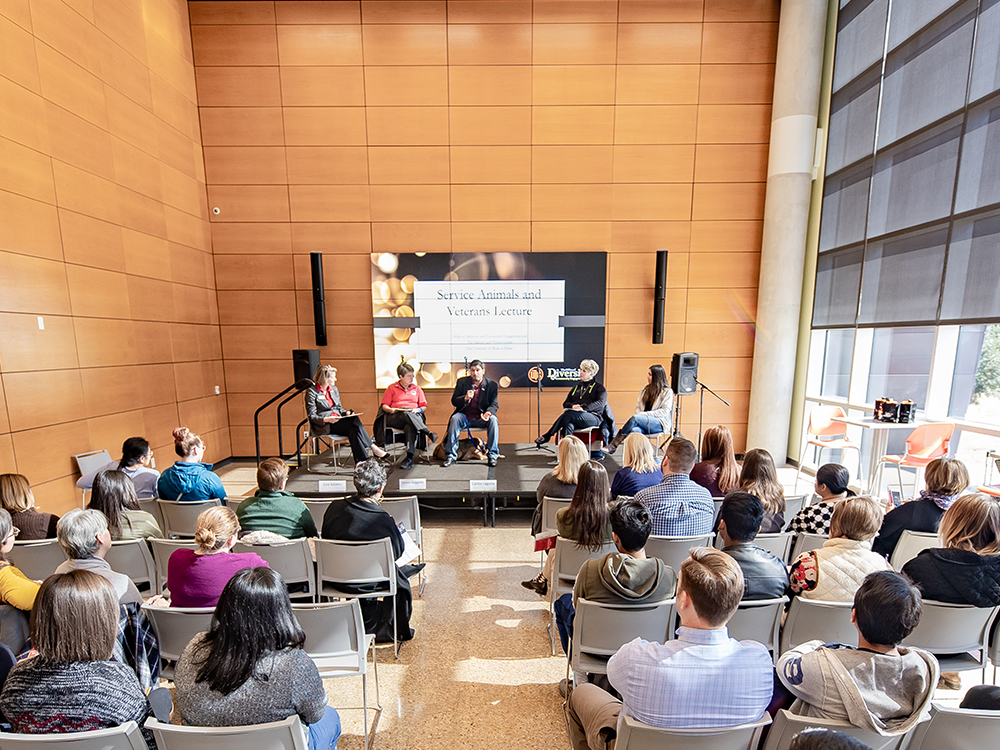The 4-1-1 on Service Dogs
11.15.2018
 Janeen Baggette, founder of K9’s For Freedom & Independence, listens as UT Dallas student veteran Carlos Laguna (center) shares during a panel discussion how his service dog, Mattis, has helped relieve his anxiety.
Janeen Baggette, founder of K9’s For Freedom & Independence, listens as UT Dallas student veteran Carlos Laguna (center) shares during a panel discussion how his service dog, Mattis, has helped relieve his anxiety.
When Carlos Laguna, a senior in the School of Arts, Technology, and Emerging Communication, was medically separated from the Marine Corps after serving with Operation Iraqi Freedom, he continued to experience debilitating flashbacks, blackouts and anxiety.
Those symptoms eased when he connected with 8-month-old German boxer service dog Mattis, whom Laguna named after his former commander in Iraq, now U.S. Secretary of Defense Gen. James Mattis.
“Although there’s nothing ‘mad dog’ about him,” Laguna said of his beloved canine companion.
 Mattis, now 8, has been a service dog for UT Dallas student and Marine Corps veteran Carlos Laguna since he was a puppy.
Mattis, now 8, has been a service dog for UT Dallas student and Marine Corps veteran Carlos Laguna since he was a puppy.
Mattis was specially trained to interact with his owner – licking his face, whining or even tapping him with a paw – whenever Laguna had a nightmare or became anxious.
“He gives me a check to remind me that I have a decision to make. He helps pinpoint my anxiety. He knows when to intervene,” Laguna said.
Laguna shared his experiences during a Service Animals and Veterans panel Nov. 14 at UT Dallas. The panel featured dog trainers from nonprofit organizations that provide veterans with service dogs, and representatives from the UT Dallas Military and Veteran Center (MVC) and the Office of Student AccessAbility. The MVC and the Office of Diversity and Community Engagement sponsored the event.
 Panelists explain how service animals assist military veterans. From left are: Lisa Adams of the Military and Veteran Center; Janeen Baggette, founder of K9’s For Freedom & Independence; student veteran Carlos Laguna; Kerry Tate, director of the Office of Student AccessAbility; and Maria Bruno, training manager of Canine Companions for Independence.
Panelists explain how service animals assist military veterans. From left are: Lisa Adams of the Military and Veteran Center; Janeen Baggette, founder of K9’s For Freedom & Independence; student veteran Carlos Laguna; Kerry Tate, director of the Office of Student AccessAbility; and Maria Bruno, training manager of Canine Companions for Independence.
Panelists explained that service dogs are not the same as emotional support animals, which are considered merely therapeutic. Service dogs are trained to do specific tasks, such as picking up things or turning lights on and off, to mitigate their person’s particular handicap. Because they perform essential tasks, they often wear vests indicating that they are service animals.
Volunteers with Canine Companions for Independence and K9’s For Freedom & Independence brought service dogs-in-training and shared proper etiquette for approaching a dog on duty.
• You don’t have to ignore or avoid eye contact with a service dog.
• If you want to pet a service dog, always ask the handler – then respect their answer. Some don’t mind when people pet their dogs; others prefer their dogs not be touched.
• Do not engage in “drive-by petting” as you walk past a service dog.
• If it’s a guide dog whose handler is using its harness, consider it to be working and avoid contact so you don’t distract the dog.
 A service dog-in-training sits at the feet of Maria Bruno of Canine Companions for Independence.
A service dog-in-training sits at the feet of Maria Bruno of Canine Companions for Independence.
“Think about it. You don’t pet a wheelchair, so don’t pet my service animal when he’s working,” said Kerry Tate, director of the Office of Student AccessAbility.
Mattis now 8 and sporting a gray muzzle, wears a vest that was specially tailored for him from one of Laguna’s old military shirts. He accompanies Laguna everywhere, even to classes at UT Dallas. Thanks to his faithful attention, Laguna said he hasn’t had any flashbacks or blackouts in several years, and he’s learned to recognize his stress triggers.
“Mattis has really helped control my anxiety levels. He’s even helped me learn patience because he would shut down if I got irritated,” Laguna said. “Mattis chose me, I always say. He came up to me and put his head on my lap. He hadn’t done that with anyone else. The trainer told me, ‘I guess you’re stuck with him.’”
–Robin Russell
Tags: Campus